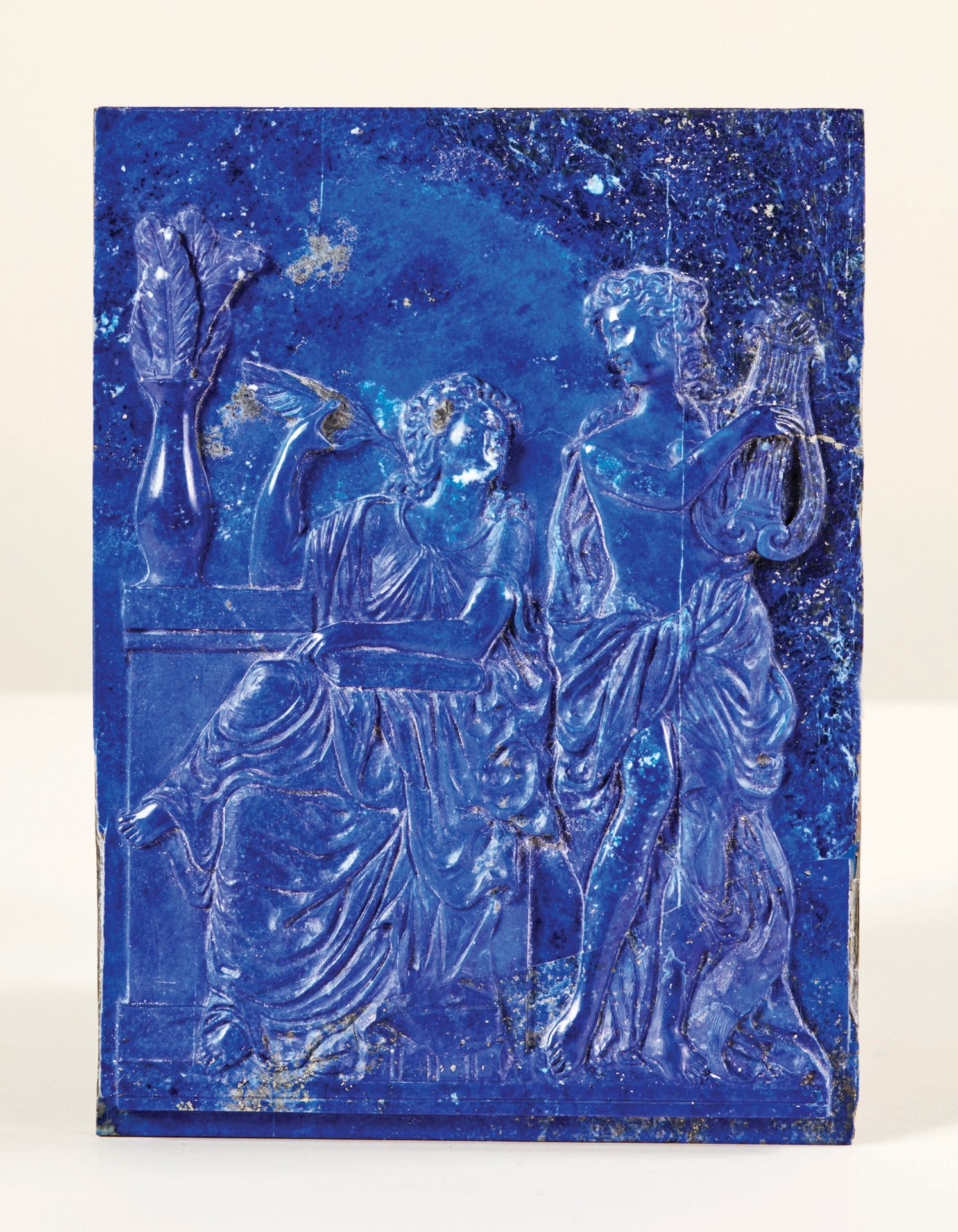Description
Rare and large lapis lazuli plaque carved in bas-relief representing the Muses of Poetry and Music, pasted on a slate. Poetry is seated near a feathered vase on a pedestal, her left arm resting on a closed book; she holds a feather in her right hand and turns towards Music, standing beside her playing the lyre. From a marble bas-relief by Jean Rousselet (Paris, 1656- Paris, 1693), late 17th century Height: 20.5 cm - Width: 14.8 cm In a gilded wooden frame Provenance: former Spanish collection Large lapis lazuli plaques are rare, and even more so those that are carved. As lapis is mined in small quantities, they are usually made up of several pieces, and here the lapidary has added a fragment to the lower part. This representation of the Muses of Poetry and Music was probably commissioned by a person close to the royal circle. It is based on a large marble bas-relief that the sculptor Jean Rousselet delivered as a reception piece for the Académie on June 28, 1686, entitled "La Poésie et la Musique célébrant la gloire de Louis XIV" (Poetry and Music Celebrating the Glory of Louis XIV), now in the Louvre collections (inv.MR 2764, N 15415, fig.). One of many siblings, Jean was the son of Gilles Rousselet, a well-known engraver, academician and friend of Le Brun. He spent time in Rome and was admitted to the Academy after the presentation of the large bas-relief on the muses. In order to adapt to a smaller size and to meet the aspirations of the commissioner, Rousselet's composition was simplified and the portrait of the king on the left was replaced by a vase decorated with feathers. It seems that two lapidaries were involved in this work, one in charge of the figures and the other of the drapery. This large cameo in lapis shows a great refinement of execution playing on the treatment of the surfaces, carefully polished for the heads and bodies and left rougher for the draperies and attributes. No other plate of comparable dimensions, made of this very sought-after and expensive material for the time, is known, which confirms its rarity and constitutes a precious testimony of the work of the lapidary of the end of the Grand Siècle. Book consulted: F. Souchal, French Sculptors of the 17th and 18th centuries - The reign of Louis XIV, Oxford, 1987, Vol. 3, p 268-270.
106
Rare and large lapis lazuli plaque carved in bas-relief representing the Muses of Poetry and Music, pasted on a slate. Poetry is seated near a feathered vase on a pedestal, her left arm resting on a closed book; she holds a feather in her right hand and turns towards Music, standing beside her playing the lyre. From a marble bas-relief by Jean Rousselet (Paris, 1656- Paris, 1693), late 17th century Height: 20.5 cm - Width: 14.8 cm In a gilded wooden frame Provenance: former Spanish collection Large lapis lazuli plaques are rare, and even more so those that are carved. As lapis is mined in small quantities, they are usually made up of several pieces, and here the lapidary has added a fragment to the lower part. This representation of the Muses of Poetry and Music was probably commissioned by a person close to the royal circle. It is based on a large marble bas-relief that the sculptor Jean Rousselet delivered as a reception piece for the Académie on June 28, 1686, entitled "La Poésie et la Musique célébrant la gloire de Louis XIV" (Poetry and Music Celebrating the Glory of Louis XIV), now in the Louvre collections (inv.MR 2764, N 15415, fig.). One of many siblings, Jean was the son of Gilles Rousselet, a well-known engraver, academician and friend of Le Brun. He spent time in Rome and was admitted to the Academy after the presentation of the large bas-relief on the muses. In order to adapt to a smaller size and to meet the aspirations of the commissioner, Rousselet's composition was simplified and the portrait of the king on the left was replaced by a vase decorated with feathers. It seems that two lapidaries were involved in this work, one in charge of the figures and the other of the drapery. This large cameo in lapis shows a great refinement of execution playing on the treatment of the surfaces, carefully polished for the heads and bodies and left rougher for the draperies and attributes. No other plate of comparable dimensions, made of this very sought-after and expensive material for the time, is known, which confirms its rarity and constitutes a precious testimony of the work of the lapidary of the end of the Grand Siècle. Book consulted: F. Souchal, French Sculptors of the 17th and 18th centuries - The reign of Louis XIV, Oxford, 1987, Vol. 3, p 268-270.
